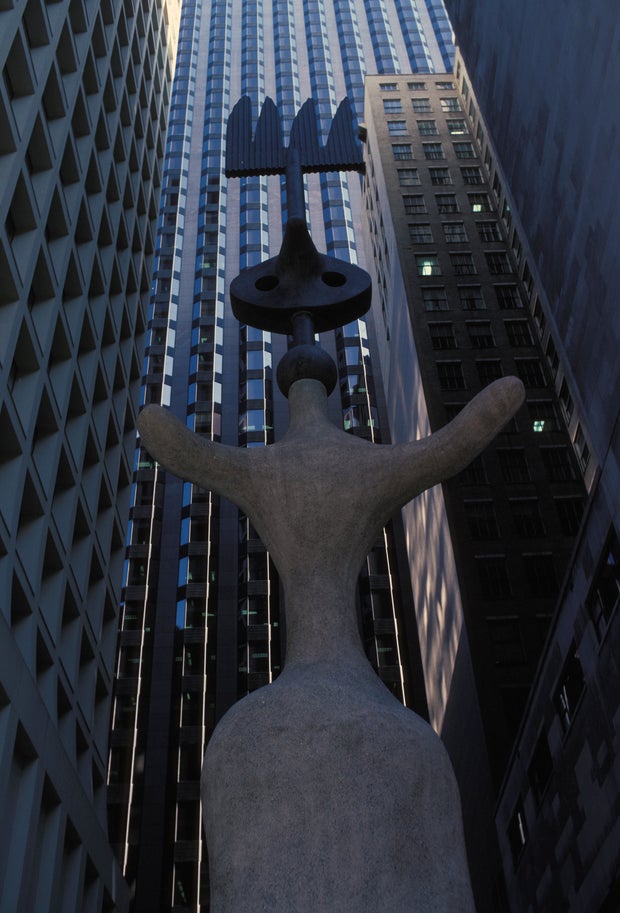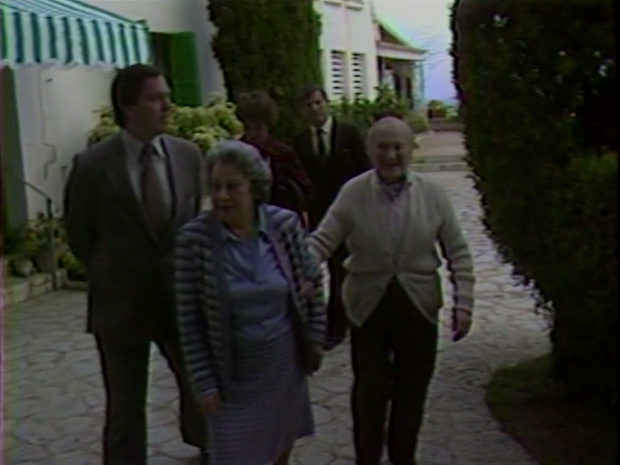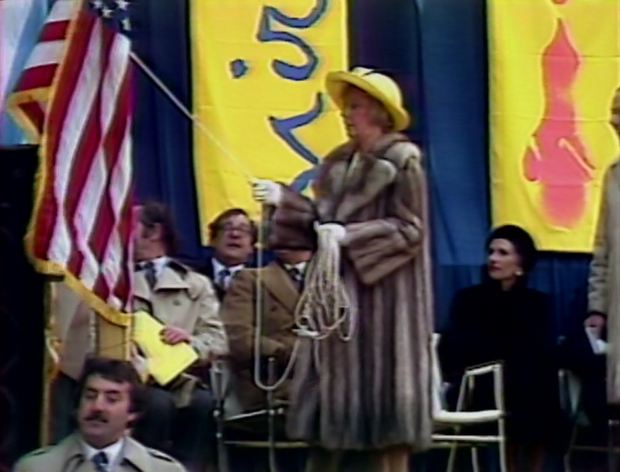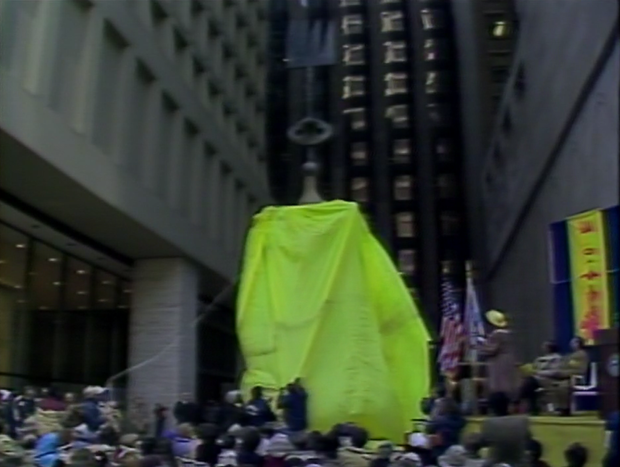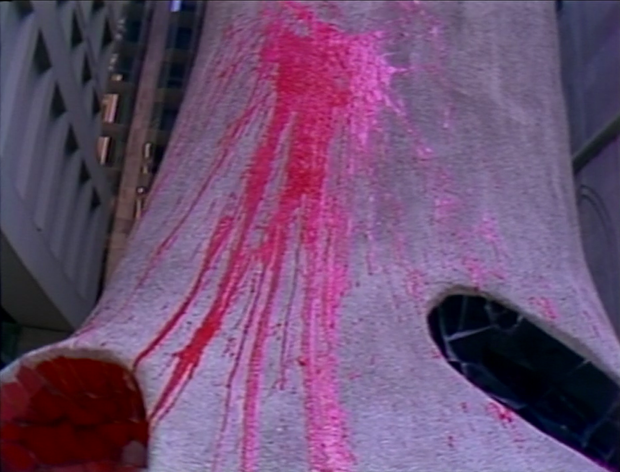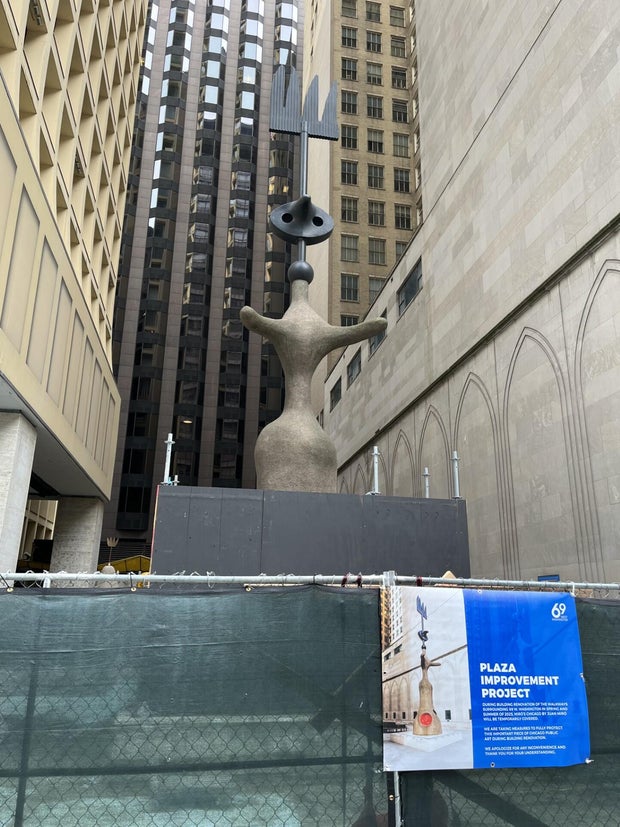On this day in 1981: Joan Miró's Chicago sculpture is unveiled downtown
On April 20, 1981 — 44 years ago Sunday — a long-awaited piece of public sculpture was unveiled to a crowd on a chilly day in downtown Chicago.
Going back to the 1960s, a sculpture by Spanish Catalan artist Joan Miró had been part of the plan for the plaza next to the George W. Dunne Cook County Office Building — previously known as the Cook County Administration Building and originally the Brunswick Building.
The building at 69 W. Washington St. was completed in 1964, and architect Bruce Graham of Skidmore, Owings & Merrill told Betty Blum of the Society of Architectural Historians that he was talking with Miró about the sculpture when the building was still in its early planning stages. But at first, the Brunswick Corporation — which used the building as its headquarters before Cook County took over — decided not to have it built, Graham said.
In the meantime, Pablo Picasso's iconic untitled sculpture in Daley Plaza — then known as Civic Center Plaza — was unveiled in 1967.
Finally, more than 15 years after the Miró sculpture was first proposed, a deal was finally reached to have it built with the cost split between the City of Chicago and private fundraisers, according to Skidmore, Owings & Merrill. Miró donated his design as a gift to the city, and at last on that chilly day a few months into President Ronald Reagan's first term, the sculpture known as "Miró's Chicago" made its debut.
Joan Miró: A living legend at the time
Joan Miró (his first name is pronounced "zho-AHN") was born April 20, 1893, in Barcelona. He began business school there at the age of 14 while also attending art school, but ended up abandoning business for art studies following a nervous breakdown, according to a biography from the Guggenheim.
Miró attended Francesc Gali's Escola d'Art in Barcelona between 1912 and 1915, and art dealer Josep Dalmau staged Miró's first gallery show in Barcelona in 1918, according to the Guggenheim. He went on to split his time between Paris and Mont-roig, Spain, and he joined the Surrealist group — an avant-garde creative movement led by poet André Breton. Miró's work appeared in the First Surrealist Exhibition in Paris in 1925 — along with works by other masters such as Max Ernst, Paul Klee, Man Ray, and Picasso himself.
But as noted by the Metropolitan Museum of Art, Miró was branching out from the Surrealists by the end of the 1920s. He began to experiment with novel materials and artistic techniques, and began developing collages, sculptures, and artworks on paper during the 1930s, the Met noted.
In 1941, Miró had his first major museum retrospective at the Museum of Modern Art in New York City. After World War II, he settled in Palma, Majorca, Spain, where he began working with ceramics and making models for large-scale abstract sculptures, the Met noted.
"Miró's Chicago" — completed toward the end of the artist's life — was just such a creation. The 36-foot sculpture, originally known as "The Sun, the Moon and One Star," was built from steel, concrete, bronze, wire mesh, and some colorful ceramic tile.
A description published by the Public Art Archive describes the sculpture as being imbued with "the mystical presence of an earth deity, both cosmic and worldly." The bell-shaped base — with its red, black, and blue tile patterns — represents Miró's association of the female form with the earth, the spherical center represents the moon, and the shape of the face is based on a ceramic hook, the Public Art Archive notes.
The fork on the top of the sculpture's head represents a star, with each tine representing a ray of light, according to the Public Art Archive.
The grand unveiling
Ahead of the long-anticipated unveiling of the sculpture, Bill Kurtis and his Focus Unit celebrated the artwork and the artist with a special Channel 2 News report — which included a visit to Majorca, Spain for an interview with Miró.
When asked by Kurtis what he hoped people looking at his work on Washington Street in Chicago would think about upon seeing it, Miró said through an interpreter that he hoped they would "think that they're looking at something marvelous, and that tickles them up here," while rubbing his forehead.
The complete Focus Unit documentary, unfortunately, is not available in the CBS Chicago archive. But we did find Kurtis' complete raw interview with Miró in Majorca, Spain. The tape is dated March 26, 1981.
Monday, April 20, 1981, was Miró's 88th birthday. It was also the day that Mayor Jane Byrne pulled a cord to unveil Miró's iconic contribution to the aesthetics of downtown Chicago. But everything did not quite go as planned that day.
In a Chicago Tribune report, Kurtis noted that he and CBS Chicago talk show host Lee Phillip co-anchored the dedication of Miró's sculpture — this, unfortunately, is not available in the CBS Chicago archive either.
The Chicago Symphony Orchestra was also supposed to play, but it was too cold and their instruments risked being damaged. A massive crowd turned out nonetheless to see Mayor Byrne unveil the sculpture sometimes called "Miss Chicago."
"As the years go by, as we continue to appreciate the work of the masters, that I myself will know that not just the city that works, but the city that has sort of a little heart, played a role today in Joan Miró's birthday in saying the commitment that was made to you in the 50s — to you, Picasso, and to you, Miró — is now completed," Mayor Byrne said. "It's a city that loves you. It's a city that loves its art. It's a city that loves itself. And for that reason, I'm delighted that today we have the completion of a promise."
Leo Arnaud's "Bugler's Dream" — better known as the Olympic Anthem — played as Mayor Byrne tugged a rope to send the yellow veil dropping free.
The veil did not cooperate at first, and the fur coat-clad mayor had to keep tugging repeatedly to get the veil off.
The crowd applauded when the veil fell and the sculpture was revealed at last.
One man called the sculpture "the high energy and style that's Chicago." But speaking to the late Channel 2 reporter and intrepid adventurer Bob Wallace, few seemed to be in agreement that it looked particularly like a woman. One man even called the sculpture "ugly" and said he didn't like it at all.
It took less than two weeks for Miró's Chicago to be back in the headlines again. On May 1, 1981, as a May Day rally was going on downtown, someone threw a container of oil-based red paint at the base of the sculpture.
Police quickly arrested art student Crister Nyholm, 24, of Chicago's Ravenswood neighborhood. Police said at the time that they were already in the area when the vandalism happened, and responded to the scene to find Nyholm just sitting there staring at what he'd done.
As Channel 2 News reporter Frank Currier reported, Nyholm told police at the time that he vandalized the sculpture because he hated it, and it was something he had to do. Third Coast Review reported that art conservators from the Art Institute of Chicago stripped off the paint, and a judge sentenced Nyholm to probation and imposed a fine.
Miró died Dec. 25, 1983, at the age of 90.
In 2025, 44 years after it was unveiled, Miró's Chicago still stands proudly in the plaza between the George W. Dunne Cook County Office Building and the Chicago Temple. The sculpture will be covered temporarily this spring and summer during renovations of the walkways surrounding the county office building, and all measures are being taken to ensure it is protected to go back on proud display once the work is done.

